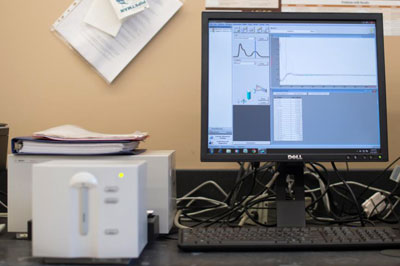Otto H. York Center for Environmental Engineering and Science
A spectrophotometer is an instrument for measuring the transmittance or absorbance of a sample as a function of the wavelength of electromagnetic radiation. Used mostly for quantitative analysis of molecular or ionic species in solution.
Agilent, Model 8453 UV-Visible Spectrophotometer
- Wavelength range: 190 – 1100 nm
- Resolution: 1 nm slit width
- Full control of the spectrophotometer is solely by the general purpose UV-Visible ChemStation Software.

What is a Spectrophotometer?
A spectrophotometer is an instrument for measuring the transmittance or absorbance of a sample as a function of the wavelength of electromagnetic radiation. The components of a spectrophotometer include:
- a source that generates a broad band of electromagnetic radiation,
- a dispersion device that selects from the broadband radiation of the source a particular wavelength,
- a sample area,
- one or more detectors to measure the intensity of radiation.
What are the sources of Radiation used in UV-Visible Spectrometers
Two sources are commonly used in UV-Visible spectrophotometers:
- The deuterium arc lamp. Provides a good intensity continuum in the UV region and useful intensity in the visible region. A half-life of the lamp (the time required for the intensity to fall to half of its initial value) is approximately 1,000 hours.
- The tungsten-halogen lamp. Yields good intensity over part of the UV spectrum and over the entire visible range. Has useful life of 10,000 hours.
How to choose a sample-cell (cuvete) for my application
- Fused quartz cells are transparent down to 210 nm (190 nm .– the best cells)
- Glass cells are not suitable for measurements below 320 nm
- Plastic cells (polystyrene, methacrylate), lowest in cost, disposable absorb strongly below 300 nm (see Table). These cells are not resistant to all solvents.
Wavelength, nm
% Transmission
Polystyrene
Methacrylate
A wide range of cells is available for users of instrumentation at Material Characterization Laboratory:
Material
Lightpath, mm
Capacity, ml
Spectral Range, nm
Polysterene
Methacrylate
Semimicro Plastic Rectangular Cells - disposable
Polysterene
Methacrylate
Quartz
Quartz
Quartz
Quartz
Glass
Cylindrical Cells with PTFE stoppers
Quartz
Quartz
UV-Silica
Fluorescence cells (all sides and bottom are optically polished)
Quartz
Cell Types?
- The most frequently used cell is the open-topped rectangular cell with path length of 10 mm (quartz cells of 3.0 ml capacity).
- Micro (0.5 ml capacity) or semimicro (1.0 ml capacity) cells are used when sample volume is limited.
How to Choose Solvent for my Application?
The ideal solvent for the preparation of sample solutions:
- dissolves all types of compound,
- completely transparent at all wavelengths,
- nonflammable and nontoxic.
Distilled water would be ideal for for spectrophotometric measurements but is not suitable for nonpolar organic compounds. With volatile organic solvents, such as acetone, methylene chloride, use a stopper cell in order to eliminate evaporation (results in changes in concentration). See table for properties of some common solvents.
Polarity*
Cut-off wavelength (nm)**
Hazard
Distilled water


